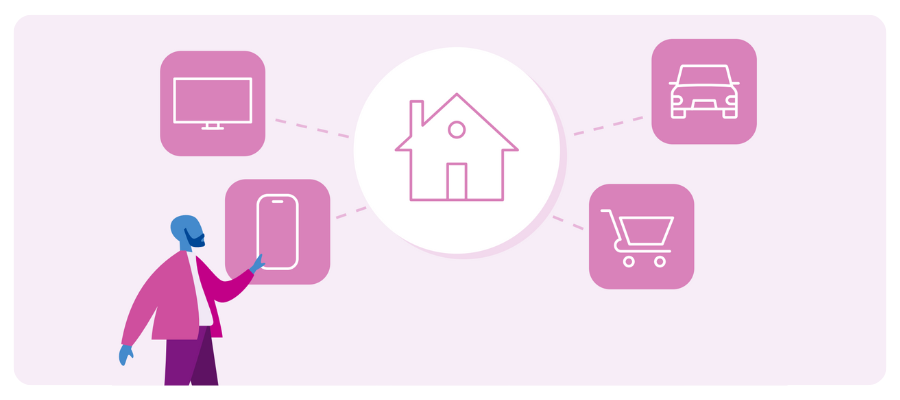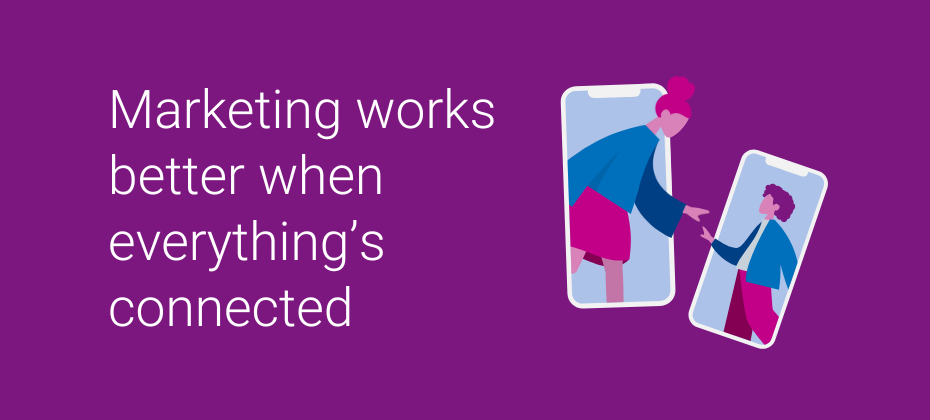
Originally appeared in The Current
Forget the cookie delay — AI is already rewriting the rules of advertising.
While the industry was busy debating yet another postponement of Chrome’s third-party cookie phaseout, AI quietly became the most disruptive force in marketing. But here’s the twist: AI doesn’t work without identity. If marketers want results — real outcomes, not just impressions — they need to prioritize the data that makes AI go.
First-party data strategies are now mainstream. Interoperable identity solutions like Unified I.D. 2.0 (UID2) and ID5 are gaining adoption across the open web. Connected TV (CTV) has grown into a performance-focused, cookieless channel. Contextual and geo-based targeting have become smarter and more scalable. Identity graphs are helping marketers stitch together signals across devices, platforms, and channels.
The foundation for a better ecosystem isn’t being built — it’s already here.
The AI hype is over — and the stakes are higher
It’s no longer buzz. AI is here, and it’s already reshaping how we plan, activate, and measure advertising.
We’re seeing the rise of agentic AI: systems that don’t just surface insights but act on them. These AI agents are identifying patterns, building audiences, optimizing media buys, and analyzing performance. AI is helping marketers stop guessing and start improving.
But there’s a catch — one we can’t afford to overlook.

AI is only as good as the data it works with. “Garbage in, garbage out.” as the saying goes. And in advertising, that means if you don’t know who you’re reaching, even the smartest AI won’t drive results. To unlock AI’s full potential, marketers need a strong, privacy-safe identity foundation.
Identity is the fuel that makes AI work
AI can personalize creative, optimize in-flight campaigns, and even recommend which channels to prioritize — but it can’t do any of that well without context. And context starts with identity.

Identity connects signals from different devices, logins, channels, and interactions to real people. It tells your AI models who you’re talking to — not just what they clicked. That kind of clarity gives AI the power to make smarter predictions, uncover insights, and deliver relevance at scale. Without identity, AI is guessing. With identity, it’s delivering.
Identity is the foundation of the outcomes era
We’re living in a performance-driven age. Impressions and clicks are no longer enough. Marketers today are being judged by real outcomes: incremental sales, customer acquisition, revenue lift, and long-term value.

To measure those outcomes, you need to know who you reached — and whether they took action. Identity makes that connection possible. It links ad exposure to real-world results. It enables accurate attribution across channels. It powers personalization at every stage of the journey, making every impression more valuable.
This is the outcomes era, and identity is what makes it measurable.
Commerce media and CTV show what’s possible
Two of the fastest-growing channels — commerce media and CTV — are great examples of identity in action.
At Experian, we’ve invested in this future. Our recent acquisition of Audigent brings together data, identity, and activation — under one roof — built to support both AI-driven planning and outcome-based performance.
How marketers can win now
To stay ahead in a world defined by AI and outcomes, marketers need to:
It’s not about rebuilding everything. It’s about building on what’s already working.
Final thought: Identity is the bridge
AI is raising the bar, and outcomes are the new standard. But neither works without identity. The marketers who win won’t treat identity as a compliance checkbox — they’ll treat it as their competitive edge.
Get started with us today
Latest posts

Originally appeared in AdExchanger Google’s decision not to deprecate cookies in the Chrome browser after all caused a stir across the industry. Companies invested heavily in developing solutions aligned with the Privacy Sandbox as a survival tactic for the post-cookie landscape. At first glance, Google’s about-face may appear to undercut those efforts. It’s easy, and perhaps even satisfying for some – but inaccurate – to say “all that effort was for nothing.” Given Chrome’s dominance among browsers, AdTech companies had no choice but to prepare for “what if” scenarios. The same goes for cookie deprecation. Google’s plan to end support for third-party cookies would have removed a mechanism that has been a cornerstone of addressability for the past 15 years. To be clear, those efforts have not been wasted. They spurred innovation across the AdTech landscape, driving progress in privacy-first targeting, alternative identifiers, supply-path data activation, and real-time data enrichment – all of which will pay dividends for years to come. Whether born directly from Privacy Sandbox participation or inspired by the broader trend toward privacy reform, industry-wide preparation for cookie loss and browser disruption has yielded tangible benefits. Pressure from Google, Apple, and evolving regulations served as a catalyst for modernization that could shape the next decade of advertising technology. An industry anchored in product innovation AdTech is a fundamentally product-driven industry defined by short innovation cycles and the imperative to build and test rapidly. This DNA enables companies to stay resilient, evolve and deliver innovation. Change is good. Disruption can be even better – but only for those who embrace it. Google’s evolving stance on cookies and Privacy Sandbox doesn’t negate what’s been learned. If anything, it underscores the need to keep innovating. The next wave of disruption is likely right around the corner. The payoff While some may argue that the time and effort spent preparing for cookie loss was wasted, those efforts have functioned as a forcing mechanism for several innovations in data activation. Supply-side data activation and optimization, aka “curation,” is an alternative to the traditional approach to data activation. Unlike the traditional data management platform (DMP) to demand-side platform (DSP) activation flow, curation allows buyers to utilize supply-path data more directly. The upshot? Improved performance and pricing for media agencies and brand advertisers. As curation continues to evolve, it’s poised to play a central role in how advertisers and publishers transact. Real-time data enrichment is another area that has benefited from this period of accelerated innovation. Many companies were compelled to improve their tech stacks to align with Sandbox protocols. These updates, particularly in real-time data enrichment capabilities, are now laying the groundwork for future data activation strategies across both the buy and sell-sides. Exiting out of tunnel vision Over the past five years, the AdTech industry has invested deeply in planning for a future without cookies. Still those investments have been well worth it. While cookies are not going away, the broader deprecation of signal continues. The work that was done to prepare will inevitably inform the next evolution of our industry. Contact us Latest posts

Marketers are under more pressure than ever to deliver personalized, high-performing campaigns—while navigating tighter budgets, shifting privacy expectations, and fragmented tech stacks. Despite an explosion of tools and data sources, the fundamentals of marketing haven’t changed. Every great campaign still starts with a simple question: Who are we trying to reach? The answer depends on how well you understand your customers. Increasingly, that understanding is hampered by data silos, inconsistent identity signals, and disconnected workflows between planning, activation, and measurement. When those pieces don’t align, it leads to inefficient spending, incomplete insights, and missed opportunities. To move forward, marketers need more than better tools—they need a more connected approach. Start with a complete view of the customer The foundation of effective marketing is understanding your audience—not just who they are, but what they care about and how to reach them across devices and platforms. That starts with building a complete customer profile. For many marketers, this means linking persistent offline data—such as name and address—with fresh digital signals like device IDs and online behaviors. When combined, these elements provide a high-fidelity view of the customer that can be enriched with attributes like demographics, purchase behavior, and lifestyle interests. This kind of profile doesn’t just help you understand people—it helps you build audience segments that actually perform. Whether you’re working with your own CRM data or third-party sources, the ability to create addressable segments that are both accurate and scalable is what separates good campaigns from great ones. 🛳️ That’s exactly what MMGY did for Windstar Cruises. By layering first-party data with behavioral and demographic insights, they built custom audiences that more than doubled campaign benchmarks. 🎮 Gaming platform Unity tapped into Experian audiences to understand player behaviors across web, mobile, and connected TV (CTV). These insights helped their advertisers reach gaming audiences more effectively—tailoring creative and delivery to real-world preferences, not assumptions. Activate with precision, not just volume Knowing your audience is only half the battle. The next challenge is reaching them—consistently and efficiently—across multiple channels. This is where fragmentation can creep back in. All too often, marketers build audiences in one system, but activate in another, causing data loss and targeting mismatches. A more connected strategy uses the same identity and audience spine across planning and activation, reducing signal loss and improving accuracy. 👉 Curated private marketplaces (PMPs), for example, allow marketers to match high-quality audiences with premium inventory in a targeted, transparent, and efficient way. These deals let marketers align their spending with their goals—whether that’s lowering cost-per-acquisition or boosting reach in a key vertical. Performance results are bearing this out: PMG By using Audigent’s curated PMP approach in combination with Experian audience data, they delivered campaigns that were 44% more cost-efficient across CTV. Boiron For Boiron, a homeopathic brand, using curated media buying reduced data costs by 30% and beat CPA goals for both video and display by more than 40%. Index Exchange Publishers benefit, too. When Index Exchange included Audigent-curated inventory in their PMPs, they saw an average 70% revenue lift for mobile and a 13% lift for CTV. When identity, audience, and inventory are aligned, everyone benefits—marketers, publishers, and consumers. Measure what matters Too often, measurement is treated as an afterthought. But in a connected campaign, it’s built in from the beginning. By using consistent identity across planning, activation, and measurement, marketers can connect ad exposure to real-world outcomes—whether that’s an online conversion, an in-store visit, or a new customer relationship. This kind of closed-loop measurement turns marketing into a learning engine. You don’t just see what happened—you understand why it happened and can use that information to improve the next campaign. 🛳️ In the case of Windstar Cruises, MMGY used Experian identity to precisely measure how digital ad exposures translated into bookings. That kind of visibility gives marketers more than a report card. It gives them the feedback they need to optimize smarter next time—and prove ROI every time. The future is connected To meet today’s demands, marketers need a new way of working—one that starts with a complete understanding of the customer, builds addressable audiences on a strong identity foundation, activates them precisely across channels, and measures impact in real time. The marketers embracing this approach are already seeing results: stronger performance, more efficient spending, and deeper insights that power what comes next. The future won’t be built on more tools—it will be built on more connection. Connect with us Latest posts

Curation — the intelligent packaging of data and inventory actionable in a private marketplace deal — can no longer be considered a trend or buzzword. With over 66% of all open exchange – representing $100 billion in annual spend – being transacted through private marketplace deals (PMPs), curation is a key part of how data and identity are addressed and actioned in programmatic media. Programmatic advertising is certainly known for big shifts, but as shared by Index Exchange CEO Andrew Casale, “Curation will be bigger than header bidding and as big as programmatic or real-time bidding (RTB) – that’s our bet.” And we agree. But why has curation become a critical component of brands and media agencies' digital advertising strategies? Put simply, the math. Case study after case study empirically shows curation performs well for both the buy and sell-sides. For media agencies and brands, curation consistently shows four main benefits: Significant cost efficiencies Buying curated PMPs shows significant cost efficiencies when compared to buying data from the buy-side alone. Strong performance Data-enriched, curated PMPs can be optimized through the supply path, unlike a data management platform (DMP) segment, which leads to strong performance. Futureproofs media buying When data is curated through the supply path, it does not need to rely on legacy identifiers (like cookies), and the door is open to robust, next-gen addressability which better futureproofs media buying opportunities. Value-added insights Curation comes with robust log-level data that can be used for value-added data science including analytics, insights, reporting, and attribution – all critical in a world where addressability and identity resolution are becoming even more challenging. Curation introduced efficiency into homeopathic brand Boiron’s media buys, reducing the brand’s data costs by 30%, which enabled the brand to reinvest the same budget in brand awareness goals. Curation not only met but also exceeded the CPA for display by 82% and for video by 41%. “Audigent has been a top 5 performer in terms of CPA during our testing, helping our teams deliver 44% more efficient spend for brands across CTV campaigns."Sam Bloom, Head of Partnerships at agency PMG A big boost for addressability Legacy identity signals are changing. Whether it’s by browser, device, or platform, both buy-side and sell-side platforms need strong identity signals to reach their intended audiences, and this has become harder than ever before. Curation, with its real-time data connection and enrichment capabilities, solves signal loss challenges by directly connecting to the supply path and using a broader spectrum of identity solutions to boost addressability. Curation allows platforms to target first-party, third-party, contextual, indexed and modeled audiences. This alleviates the dependence on any one identifier and boosts the relevant bidding opportunities for brands and media agencies to target audiences. Not all curation is created equally As with any hot innovation, AdTech is notorious for companies jumping on the bandwagon of the largest trends. Curation is no different, with seemingly everyone now claiming to be a “curator.” As the industry works to define what is and isn’t “curation," we are uniquely positioned to define this as Audigent has pioneered curation for seven years and is the industry leader. The definition of curation is the intelligent packaging and optimization of data curated against the inventory supply path. There are three definitional elements to any curation product: Unique audience data Curation must include first-party, third-party, contextual, indexed and/or modeled data. Robust SSP integration To apply data in real-time to the inventory supply path, a curator must have deep partnerships and integrations that enable the combination of data and inventory into a single package. Optimization The whole point of curating data against the supply path is that it opens the door for robust real-time optimization to drive performance. If the solution ticks all three boxes, then brands and agencies should test curation and gauge its results firsthand. Curation done right drives results for brands, agencies, and publishers When done well, curation improves media buying efficiency and performance for brands and agencies. Importantly, it also drives results for publishers and content creators. Advertisers realize average data segment savings of 36-81% when using PMPs over the open exchange (Internal data) Advertisers see 10-70% lower CPC, 1.5x-3.0x higher CTR, and 10-30% higher video completion rate when using data-enriched PMPs over the open exchange (Internal data) When including their inventory in curated PMPs, publishers see an average 70% revenue uplift for mobile and 13% for connected TV (CTV) Beyond voting with budgets, media agencies and brands are also weighing in on the curation conversation: “Our Conditions Marketplace strategies have driven a 48% improvement in eCPM and a 26% improvement in CPA across our pharma client portfolio as of May 2024. For one client, we saw ROAS improve by 58% compared to their overall omnichannel performance while maintaining quality. These results aren’t outliers—they’re proof that curation is no longer a nice-to-have; it’s a must-have for marketers who want performance, precision, and scale working in lockstep.”Amanda DeVito, Butler/Till Industry-leading curation with Experian Tapping into an end-to-end solution that enables marketers to understand and reach their desired customers across channels through curation is a win-win for all parties. In the past three years, Experian and curation company Audigent have delivered a range of industry-leading innovations together, including the integration of Experian data into Audigent’s PMPs. As one company now, Experian's unique identity and data capabilities amplify how curation activates on the buy-side at scale, setting a new standard for audience targeting with added benefits like audience customization and flexible activation through Audigent’s PMPs or demand-side platforms. Connect with us Latest posts





